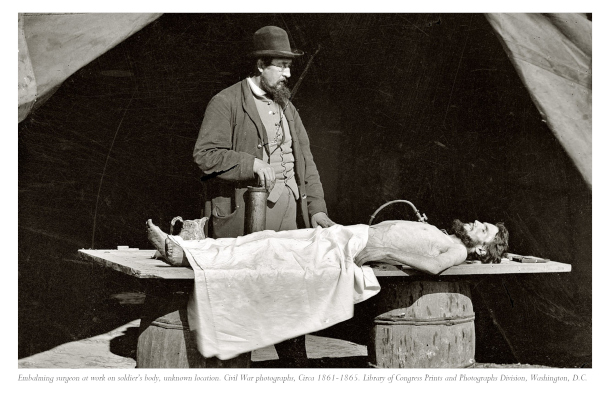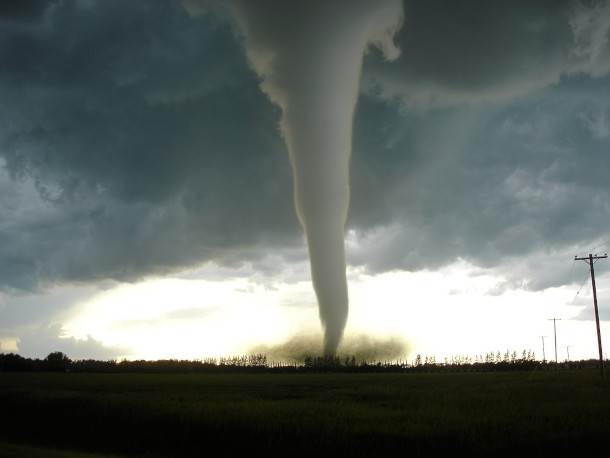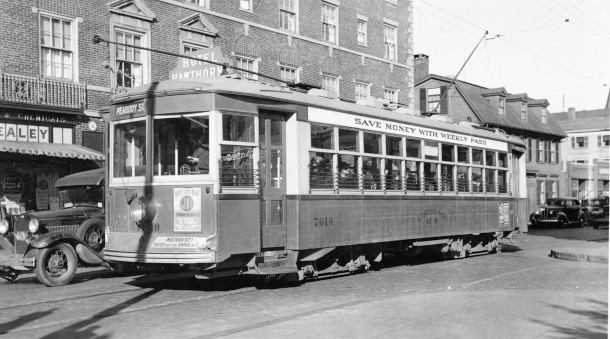Beyond the Headlines
Air Date: Week of April 7, 2023

Embalming became common practice during the Civil War to preserve soldiers’ bodies so they could be buried at home. (Photo: Wagner Free Institute of Science, Flickr, CC BY-NC-ND 2.0)
Living on Earth contributor Peter Dykstra joins Host Jenni Doering to share news of the uptick in green burials and a new study that finds a link between climate change and the powerful supercell storms that can give rise to destructive tornadoes. And in the history calendar, they look back 75 years to the indictment of nine corporations for allegedly conspiring to shut down streetcar lines in Los Angeles and elsewhere and replace them with buses made or fueled with their own products.
Transcript
CURWOOD: It’s Living on Earth, I’m Steve Curwood
DOERING: And I’m Jenni Doering
It's that time now for a look beyond the headlines with Peter Dykstra our living on Earth contributor. Peter joins us from Atlanta, Georgia. Hey, Peter, what you got this week?
DYKSTRA: Hi, Jenni, we'll start out with a little unconventional news. It's something that's been around for a while, but apparently on the increase, and those are green burials.
DOERING: And by the way, what is a green burial?
DYKSTRA: Well, it involves putting the body in a wrap inside, some cases of bamboo casket rather than a metal one, and in every way, making it less toxic, and I think more practical. Up until the American Civil War, green burials were the standard because there weren't embalming chemicals and a lot of money for expensive funerals. And also people tended to die close to home. But when the Civil War came around, men were dying in battlefields, hundreds of miles from home, and they needed to be preserved in order to be sent back home for proper burial.
DOERING: And one can see why embalming bodies during the Civil War would be so important, but that involves a lot of chemicals. Right, Peter?
DYKSTRA: A lot of chemicals, a lot of other hardware. There are some stats from the Green Burial Council. They say that 4.3 million gallons of embalming fluid go into the ground each year in graveyards, and 10 times the amount of carbon is emitted from a traditional burial than is admitted in a green burial.
DOERING: Well, and what about cremation, Peter? I mean, you know, burning our bodies that leaves behind just a little bit of ash.
DYKSTRA: Well, that involves up to a couple of hours of time in the furnace at nearly 2000 degrees equal to driving a car 500 miles.
DOERING: Well, Peter, what else do you have for us this week?

A new study indicates that there may be a connection between climate change and the weather systems that sometimes precede the emergence of extreme tornados. (Photo: Justin Hobson, Wikimedia Commons, CC BY-SA 3.0)
DYKSTRA: Well, this is a pretty important study. Let's hope we didn't bury the lead. But from the University of Northern Illinois, and the United States Air Force science office. A recent study says that there may be a link between climate change and extreme tornadoes. We've long since known a lot of the impacts of climate change. Tornadoes have never been proven to have climate change and warming weather as a cause.
DOERING: Wow. So what are the links that they're seeing between climate change and tornadoes?
DYKSTRA: It's actually the precursors to a lot of major storms, the supercells, that can cause tornadoes, like the ones we saw recently, from the Gulf Coast in the south, up to the Midwest. Those tornadoes may have that link to climate change because extreme tornadoes, according to the study, might be moving farther east. Tornadoes overall, may not necessarily be as frequent, but the ones we get will be more destructive and more intense.
DOERING: Wow, so we might even need to redefine what we call Tornado Alley?
DYKSTRA: Tornado Alley is still going to get a lot of tornadoes. But overall, if we're worried about the most destructive tornadoes, this one lonely study may help prove one more major source of damage from climate change.
DOERING: Hopefully as time goes by, we'll have more studies coming out and shedding some more light on this tricky atmospheric phenomenon. Well, Peter, what do you have for us in the history calendar?

On April 9th, 1947, nine car, tire, and gas companies are convicted under anti-trust laws for conspiring to shut down streetcar lines around the country. Debate continues as to whether there really was a conspiracy. (Photo: Salem State Archives, Wikimedia Commons, CC BY 2.0)
DYKSTRA: A 75th anniversary of something that's still debated today: April 9 1947, the federal government indicted nine corporations for violating antitrust laws. Those corporations led by GM but also including Firestone Tires, Mack Trucks, Standard Oil of California, and several others were accused of conspiring to shut down streetcar lines in Los Angeles and other cities in order to replace them with buses. The trial took two years and a jury ultimately convicted them and posed token fines. The case is debated to this very day on whether or not it really was a conspiracy, or just a random conspiracy theory that the internet is so fond of.
DOERING: Well, thank you, Peter. Peter Dykstra is a living on Earth contributor, and I will talk to you again next week.
DYKSTRA: All right, Jenni, we'll talk to you soon.
DOERING: And there's more on these stories on the living on Earth website. That's loe.org.
Links
Learn about eco-friendly death options and legislation that expands green death options
Create a tornado emergency plan and donate to victims of the recent disasters
Living on Earth wants to hear from you!
Living on Earth
62 Calef Highway, Suite 212
Lee, NH 03861
Telephone: 617-287-4121
E-mail: comments@loe.org
Newsletter [Click here]
Donate to Living on Earth!
Living on Earth is an independent media program and relies entirely on contributions from listeners and institutions supporting public service. Please donate now to preserve an independent environmental voice.
NewsletterLiving on Earth offers a weekly delivery of the show's rundown to your mailbox. Sign up for our newsletter today!
 Sailors For The Sea: Be the change you want to sea.
Sailors For The Sea: Be the change you want to sea.
 The Grantham Foundation for the Protection of the Environment: Committed to protecting and improving the health of the global environment.
The Grantham Foundation for the Protection of the Environment: Committed to protecting and improving the health of the global environment.
 Contribute to Living on Earth and receive, as our gift to you, an archival print of one of Mark Seth Lender's extraordinary wildlife photographs. Follow the link to see Mark's current collection of photographs.
Contribute to Living on Earth and receive, as our gift to you, an archival print of one of Mark Seth Lender's extraordinary wildlife photographs. Follow the link to see Mark's current collection of photographs.
 Buy a signed copy of Mark Seth Lender's book Smeagull the Seagull & support Living on Earth
Buy a signed copy of Mark Seth Lender's book Smeagull the Seagull & support Living on Earth

